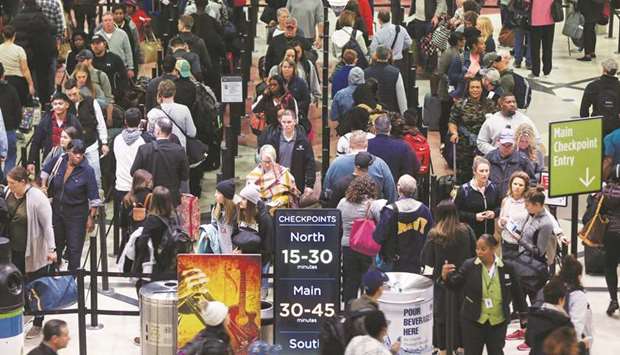By Nouriel Roubini /New York
After the synchronised global economic expansion of 2017 came the asynchronous growth of 2018, when most countries other than the United States started to experience slowdowns. Worries about US inflation, the US Federal Reserve’s policy trajectory, ongoing trade wars, Italian budget and debt woes, China’s slowdown, and emerging-market fragilities led to a sharp fall in global equity markets toward the end of the year.
The good news at the start of 2019 is that the risk of an outright global recession is low. The bad news is that we are heading into a year of synchronised global deceleration; growth will fall toward – and, in some cases, below – potential in most regions.
To be sure, the year started with a rally in risky assets (US and global equities) after the bloodbath of the last quarter of 2018, when worries about Fed interest-rate hikes and about Chinese and US growth tanked many markets. Since then, the Fed has pivoted towards renewed dovishness, the US has maintained solid growth, and China’s macroeconomic easing has shown some promise of containing the slowdown there.
Whether these relatively positive conditions last will depend on many factors. The first thing to consider is the Fed Markets are now pricing in the Fed’s monetary-policy pause for the entire year, but the US labour market remains robust. Were wages to accelerate and produce even moderate inflation above 2%, fears of at least two more rate hikes this year would return, possibly shocking markets and leading to a tightening of financial conditions. That, in turn, will revive concerns about US growth.
Second, as the slowdown in China continues, the government’s current mix of modest monetary, credit, and fiscal stimulus could prove inadequate, given the lack of private-sector confidence and high levels of overcapacity and leverage. If worries about a Chinese slowdown resurface, markets could be severely affected. On the other hand, a stabilisation of growth would duly renew market confidence.
A related factor is trade. While an escalation of the Sino-American conflict would hamper global growth, a continuation of the current truce via a deal on trade would reassure markets, even as the two countries’ geopolitical and technology rivalry continues to build over time.
Fourth, the eurozone is slowing down, and it remains to be seen whether it is heading toward lower potential growth or something worse. The outcome will be determined both by national-level variables – such as political developments in France, Italy, and Germany – and broader regional and global factors.
Obviously, a “hard” Brexit would negatively affect business and investor confidence in the United Kingdom and the European Union alike. US President Donald Trump extending his trade war to the European automotive sector would severely undercut growth across the EU, not just in Germany. Finally, much will depend on how Euroskeptic parties fare in the European Parliament elections this May. And that, in turn, will add to the uncertainties surrounding European Central Bank President Mario Draghi’s successor and the future of eurozone monetary policy.
Fifth, America’s dysfunctional domestic politics could add to uncertainties globally. The recent government shutdown suggests that every upcoming negotiation over the budget and the debt ceiling will turn into a partisan war of attrition. An expected report from the special counsel, Robert Mueller, may or may not lead to impeachment proceedings against Trump. And by the end of the year, the fiscal stimulus from the Republican tax cuts will become a fiscal drag, possibly weakening growth.
Sixth, equity markets in the US and elsewhere are still overvalued, even after the recent correction. As wage costs rise, weaker US earnings and profit margins in the coming months could be an unwelcome surprise. With highly indebted firms facing the possibility of rising short- and long-term borrowing costs, and with many tech stocks in need of further corrections, the danger of another risk-off episode and market correction can’t be ruled out.
Seventh, oil prices may be driven down by a coming supply glut, owing to shale production in the US, a potential regime change in Venezuela (leading to expectations of greater production over time), and failures by OPEC countries to co-operate with one another to constrain output. While low oil prices are good for consumers, they tend to weaken US stocks and markets in oil-exporting economies, raising concerns about corporate defaults in the energy and related sectors (as happened in early 2016).
Finally, the outlook for many emerging-market economies will depend on the aforementioned global uncertainties. The chief risks include slowdowns in the US or China, higher US inflation and a subsequent tightening by the Fed, trade wars, a stronger dollar, and falling oil and commodity prices.
Though there is a cloud over the global economy, the silver lining is that it has made the major central banks more dovish, starting with the Fed and the People’s Bank of China, and quickly followed by the European Central Bank, the Bank of England, the Bank of Japan, and others. Still, the fact that most central banks are in a highly accommodative position means that there is little room for additional monetary easing. And even if fiscal policy wasn’t constrained in most regions of the world, stimulus tends to come only after a growth stall is already underway, and usually with a significant lag.
There may be enough positive factors to make this a relatively decent, if mediocre, year for the global economy. But if some of the negative scenarios outlined above materialise, the synchronised slowdown of 2019 could lead to a global growth stall and sharp market downturn in 2020. – Project Syndicate
* Nouriel Roubini is CEO of Roubini Macro Associates and Professor at the Stern School of Business, NYU.



